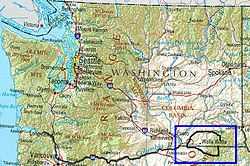Walla Walla Valley AVA
| Wine region | |
 |
|
| Type | American Viticultural Area |
|---|---|
| Year established | 1984, amended 2001 |
| Country | United States |
| Part of | Columbia Valley AVA, Oregon, Washington |
| Sub-regions | The Rocks AVA |
| Growing season | 190 to 220 days |
| Climate region | Continental/Mediterranean |
| Precipitation (annual average) | 12.5 inches (31.8 cm) |
| Soil conditions | Loess soil, unstratified calcareous silt |
| Size of planted vineyards | 1,200 acres (486 ha) |
| Grapes produced | Barbera, Cabernet Franc, Cabernet Sauvignon, Carmenere, Chardonnay, Cinsault, Counoise, Dolcetto, Gewurztraminer, Malbec, Merlot, Nebbiolo, Petit Verdot, Pinot noir, Sangiovese, Semillon, Syrah, Viognier |
| Wine produced | Varietal, Dessert wine, Sparkling wine, Meritage |
| Comments | The AVA (located within the black outline in the blue box) extends south into Northern Oregon |
The Walla Walla Valley AVA is an American Viticultural Area located within Washington State and extending partly into the northeastern corner of Oregon. The wine region is entirely included within the larger Columbia Valley AVA. In addition to grapes, the area produces sweet onions, wheat and strawberries. After the Yakima Valley AVA, the Walla Walla AVA has the second highest concentration of vineyards and wineries in Washington State.
The area is named after the Walla Walla river valley.
The soils of the Walla Walla Valley consist largely of wind-deposited loess, which provides good drainage for vines. The area receives minimal rainfall and thus relies on irrigation. The 200-day-long growing season is characterized by hot days and cool nights. The valley is prone to sudden shifts in temperature as cold air comes down from the Blue Mountains and is trapped in the Snake and Columbia river valleys. While generally cooler than the surrounding Columbia Valley AVA, temperatures in the winter time can drop to −20 °F (−29 °C). Most of the region is in hardiness zone 7a.
The southern part of Walla Walla Valley extends into the state of Oregon and is one of the warmer wine growing regions in that state, after the Rogue Valley. Syrah is a major planting in this area.
The Walla Walla Valley became an early leader in the beginnings of the Washington wine industry when the town of Walla Walla was founded by the Hudson's Bay Company as a trading post in the 1840s. French fur trappers settled in a small town outside the city known as Frenchtown near Lowden and began planting grapes. In the late 1850s, a settler named A.B. Roberts established the first nursery in Walla Walla, importing grape vines from Champoeg, Oregon. In 1859, the city of Walla Walla was incorporated and the Idaho gold rush of 1860 helped make the area a bustling trade center. When the gold rush ended, the economic focus of the state switched to Western Washington and the city of Seattle, lessening the influence of Walla Walla. In 1883, Northern Pacific Railway bypassed the Walla Walla Valley for a route from Spokane to Seattle. This essentially cut off Walla Walla from the growing market of the west. That same year a severe frost devastated the area's grapevines and caused a lot of the earlier grape growers to abandon their crops. The dawning of Prohibition in the United States in the early 20th century finished off the remaining aspect of the area as a wine region.
...
Wikipedia
